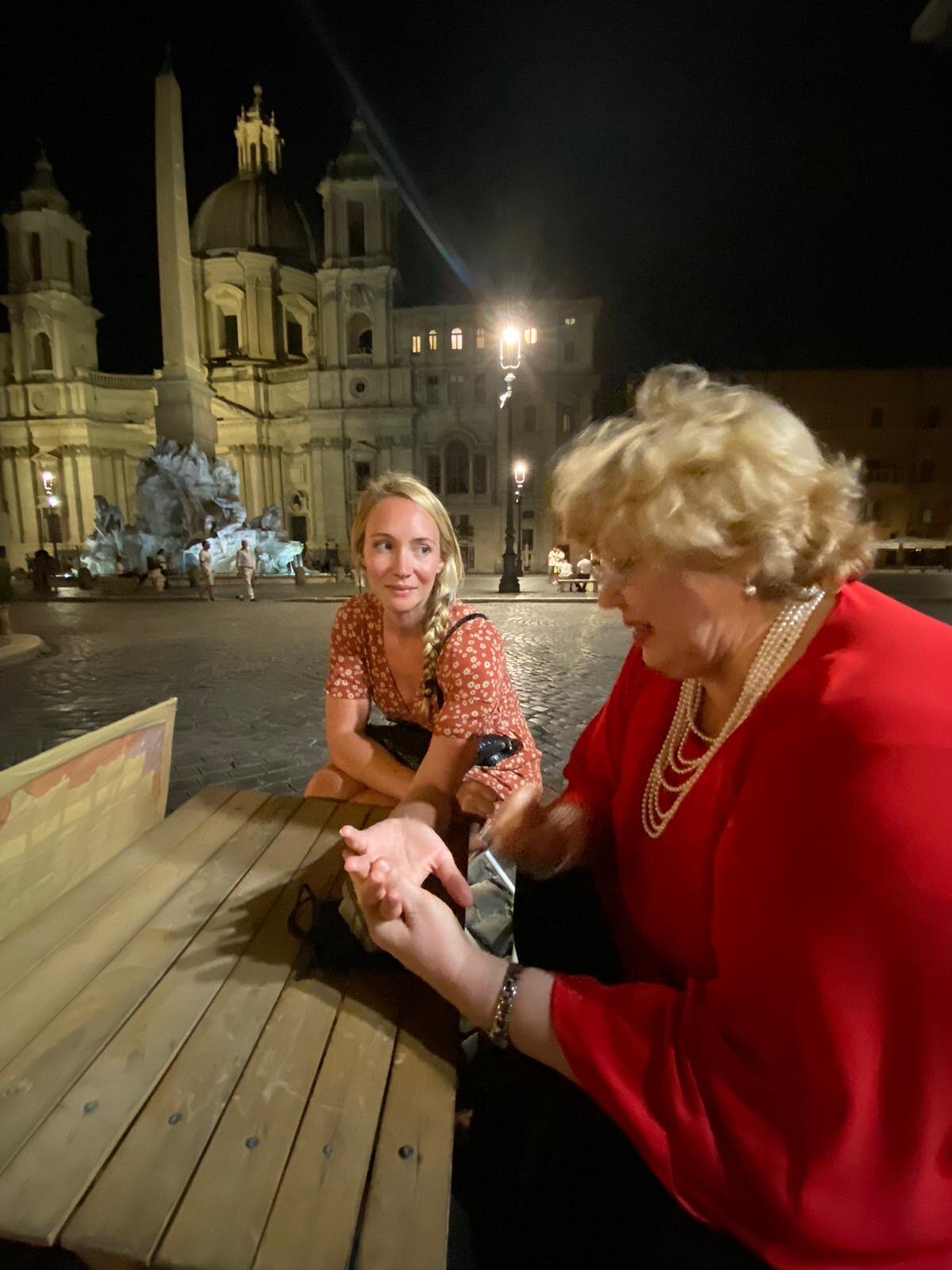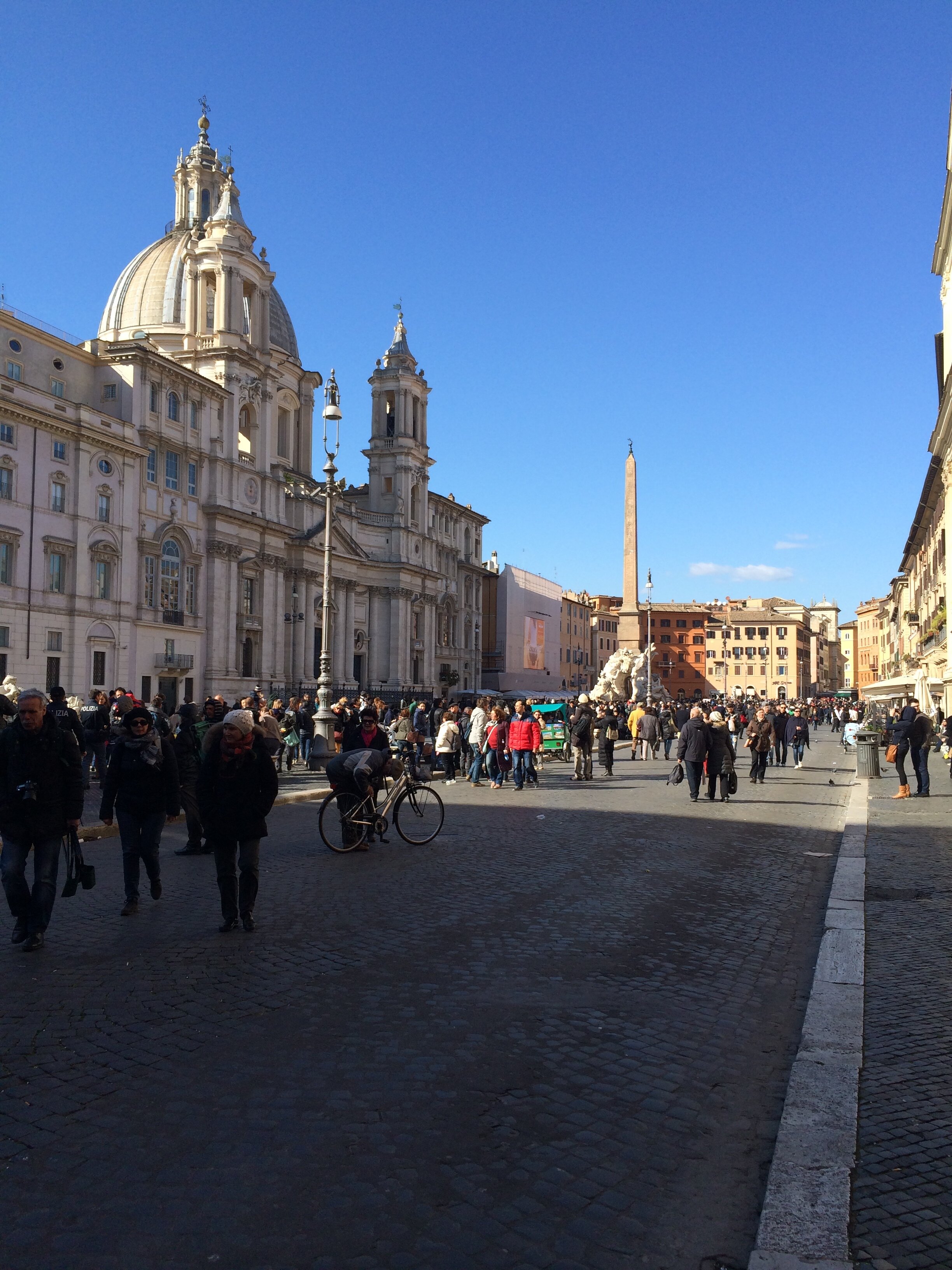Restaurant in Rome- La Montecarlo
General Introduction to Piazza Navona
The pizzeria Montecarlo is neighbor to restaurant Da Tonino, in the Piazza Navona area. Thus, I encourage you to read about this restaurant and the Via del Governo Vecchio here. There are so many worthy places tucked into the labyrinthine streets around Piazza Navona, you just need to know where to look because there are also many overpriced and inferior ‘tourist traps’ in disguise. In the introduction to Da Tonino, I discuss the long street known as Via Del Governo Vecchio which takes off from a far end of the Piazza Navona. You walk past the Brazilian Embassy on your right facing the Museo di Roma, specifically Palazzo Braschi, part of the network of Roman civic museums, and turn right. For the introduction to La Montecarlo, I would like to take this opportunity to briefly discuss the Piazza Navona itself. I will include what I consider memorable anecdotes about significant landmarks.
A focal point of the piazza is Gian Lorenzo Bernini’s 1651 Fontana dei Quattro Fiumi (Fountain of the four rivers). Commissioned by Pope Innocent X Pamphilj, the fountain both embodies common characteristics of Baroque sculpture yet, at the same time, stands as a striking and unique architectural achievement. As per convention, the coat of arms of the Pamphilj family is conspicuously displayed. Bernini’s work hugs an Egyptian obelisk, which stands 52 feet tall. It is not, in fact, authentically Egyptian (unlike some obelisks in Rome), but it was a Roman copy built to stand in the Circus of Maxentius under the Roman Emperor Domitian (reign 81 CE-96 CE). Now it is topped with the symbolic dove of the Pamphilj family. Thus, in this obelisk centuries of history are represented from ancient Roman copies of Egyptian creations to the symbol of the powerful 17th century Pamphilj family. It stands today with throngs of people, carving out space for a selfie with one of the ‘rivers’.
As expressed in the title, Bernini crafted four personified rivers, that is, the four great rivers of the 17th century world: the Nile, the Ganges, the Danube and the Rio de la Plata. Each river represents the four known continents of the time: Africa, Asia, Europe and America. The Nile in Africa is identifiable because the figure’s head is hidden representing the fact the source of the Nile was unknown at this point in history. In a less dispassionate reading, the hidden head can also represent “what the Catholic world saw as the dark ignorance of the "pagan" world: the sculpture has not seen the light of Christianity” (Read more here). Similarly, many scholars believe that the Rio de la Plata is ‘throwing’ his hand back in surprise as Christian missionaries were covering more territory in the Americas, and these lands had begun to ‘see the light’ of the Christian way. An alternative story that has become quite popular is connected to the infamous rivalry between the architect Bernini (responsible for this fountain) and Borromini (who built the large church, Sant Agnese in Agone, just in front of the sculpture). The legend tells that Bernini actually had the Rio shielding himself from his rival Borromini’s great looming church. A fun interpretation, but it is not historically accurate as construction on Sant’Agnese did not begin until 1652, at least a year after the fountain was built. The Ganges, representing Asia, is said to look apathetically away (from the light) but holds an oar to represent that the river could be navigated. ( Colonial condescension…) The Danube, as expected given the 17th century context, is represented as the most ‘civilized’ closest to and turned towards the papal coat of arms.
Step inside the massive church of Sant’Agnese, as mentioned, the Rio is not reacting in disgust, but it is a special place to understand how these two sworn architectural ‘enemies’ were working in such close proximity. Another nearby Borromini masterpiece is the church of Sant’Andrea Della Valle (read a little bit about it here). I mentioned the Brazilian Embassy earlier in the paragraph, but the larger structure is actually the Palazzo Pamphilj, built between 1644 and 1650, for the powerful family of Innocent X just after he was elected Pope. In addition to the 17th century wonders of this piazza, there is a more ancient history. Before Piazza Navona was named as such, it was a Roman arena, named the Stadio di Domiziano (stadium of Domitian) as it was commissioned by the emperor Domitian in 80 CE. Built for the people of Rome as a place for athletic competitions to take place, it originally functioned more as a Circo Massimo or Colosseo than the modern piazza we see today. In fact, for "a few years, following fire-damage to the Colosseum in AD 217, it was used for gladiator shows” (Read more here). The piazza was paved in the 15th century and thus hosted a large city market, starting the transformation into the familiar and famous piazza.
The name Piazza Navona has a rather unusual origin in that originally another Roman name for the stadio was the 'Circus Agonalis' or competition arena with agone specifically meaning games. Over the centuries the term ‘agonalis’ morphed into ‘in agone’ like the church ‘Sant Agnese in Agone’ then ‘navone’ and finally ‘navona’, a linguistic transformation without a deeper meaning, per se. It is interesting to note that ‘agone’ means agony in Italian; therefore, it would be reasonable to assume that a church named Sant Agnese in Agone refers to the agony of her martyrdom. As explained, however, this is not the case. The name of the church refers to the site of the games, harking back to the 1st century stadium. In addition to the history, the piazza has many more overpriced and inauthentic cafes around the perimeter. I recommend a full giro around the massive oval shaped piazza, take a seat on the benches in the piazza if you want to take in the view and take a rest, but head to La Montecarlo, only a short 5-minute walk away for refueling.
Restaurant Specifics
Address- Vicolo Savelli, 13
Phone- +39 06 686 00 278
Hours- Open for lunch and dinner every day except Monday
Price- Low to middle price range
Reservations-Not necessary though you might need to wait in line depending on the time and season
For a classic Roman pizzeria, I chose La Montecarlo. For one, the location is extremely central and near unmissable landmarks. Like Trapizzino (a popular 21st century Roman ‘street food’ that has become popular with locals and tourists alike) it is inexpensive, and booking a table is not necessary. No frills, frenetic service is on the menu but the pizza is authentically Roman. The fritti are good here; I recommend a suppli or a fritto misto to begin, and then each person should order his or her own pizza tondo, that is, a full round pizza. The restaurant opens at 12 PM, which is not so traditional, in the sense that, Italians historically eat pizza al taglio (pizza by the slice) at lunchtime and a full round pizza tondo for dinner. This is because it is a cultural experience to have dinner in a pizzeria and generally people will grab a quicker bite during the lunch hour, often even having the slices wrapped up to ‘mangiare camminando’ or to eat while walking. Still, as La Montecarlo is located in the heart of the area frequented by tourists, you could have the pizzeria experience at either lunch or dinner. That said, at dinnertime you will inevitably find more Italian customers. My good friend and Roman native Giorgio is a proponent of this place. He works in tourism, collaborating with Airbnb type apartment rental companies with holiday apartments in this area. He recommends La Montecarlo to guests but also frequents the place himself. We recently went together and had a quick tasty and affordable Roman pizza. The pizza romana (also called pizza bassa ‘low’ pizza referring to the thin crust) is distinct from pizza napolitana (also called pizza alta, ‘high’ pizza referring to the thick crust) in that it is thin and crispy. In fact, a word in the Roman dialect that you will hear to describe this style of pizza is scrocchiarella, which is quite onomatopoetic in Italian, resembling the sound of crunching pizza crust. You can get in and out quite quickly here, but the Roman pizza experience will not disappoint.
I have a number of good memories from this pizzeria, stopping in for a reliable bite while in the center of Rome. This is, in essence, the Italian pizzeria experience. Nothing fancy, sometimes spontaneous but always reliable. In Italian you will often hear one friend say to another ‘dai, prendiamo una pizza insieme’ (Come on, let’s grab a pizza together) or ‘ti va di andare in pizzeria’ (Are you up for going out for pizza). A pizzeria is meant to be casual; thus, in the Italian language there is a clear distinction between going to a pizzeria and going to a ristorante, which implies at least slightly more formality. I love these subtle linguistic differences as in English ‘restaurant’ is a broader term encompassing many different styles; you would need to add an adjective such as ‘casual’ restaurant.
Recommended Dishes
Antipasto- Suppli or fritto misto
Primo- pizza, of course!
Here I would go for a parmigiana (eggplant) or a classic margherita
Dolci-Walk to Gelateria del Teatro





